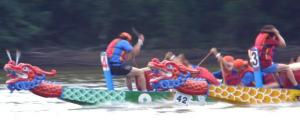

The
Chinese New Year is the biggest holiday celebrated among Chinese people. It is often referred to as the spring festival because it signals the beginning of spring. It is a time when families and friends get together to say goodbye to the old and welcome the new.
The Chinese believe that as they enter a new year, they should put behind them all things of the past. They clean their houses, pay off debts, purchase new clothes, paint their doors and window panes, and even get new haircuts. These activities symbolize new life and new beginnings. Homes are decorated with flowers and paper lanterns stating wishes of prosperity, good luck, happiness, good fortune, wealth, and longevity for the coming year.
The dragon is another popular symbol for Chinese New Year. It is a symbol of strength, goodness, and good luck, and supernatural forces. A Chinese New Year celebration would not be complete without fireworks, which are supposed to scare away all evil spirits and misfortunes, preventing them from coming into the New Year.
Because Chinese New Year follows the lunar calendar, rather than the solar calendar used in the US, the holiday never falls on the same day. On a lunar calendar, the New Year begins the first night of the new moon after the sun enters Aquarius. This date is anywhere between January 20 and February 19.
The Chinese calendar has been in continuous use for centuries, which predates the International Calendar (based on the Gregorian Calendar) we use at the present day which goes back only some 425 years. The calendar measures time, from short durations of minutes and hours, to intervals of time measured in months, years and centuries, entirely based on the astronomical observations of the movement of the Sun, Moon and stars.
There are three ways to name a Chinese year:1.
By an animal (like a mascot). There are 12 animal names; so by this system, year names are re-cycled every 12 years. This system is extremely practical. A child does not have to learn a new answer to the question, "How old are you?" in each new year. Old people often lose track of their age, because they are rarely asked about their current age. Every one just have to remember that he or she was born in the "Year of Dog" or whatever. Take, for example, the Year of Dog, any one who was born in the Year of Dog in 2006 was either 0 or 12, 24, 36, 48, 60, 72, 84 or 96 years old.
2.
By its Formal Name (Stem-Branch). The new year is the year of bingxu. In the 'Stem-Branch' system, the years are named in 60-year cycles, and the Name of the Year is repeated every 60 years. 2006 was the 7th year in the current 60-year cycle.

3. 2006 was Year 4703 by the Chinese calendar. [A few Chinese astrological/zodiac websites believe this year should be considered as Year 4704 for zodiac calculations.]
– JANUARY 29, 2006 started the Year of the Red Fire Dog
--FEBRUARY 18, 2007 started the Year of the Red Fire Pig--February 7, 2008 starts the Year of the Brown Earth Rat
On the Chinese calendar, 2008 begins the Lunar Year 4706 1912, 1924, 1936, 1948, 1960, 1972, 1984, 1996, 2008 - The Year of the Rat begins a new Zodiac Cycle. People born in the year of the RAT are blessed with great personal charm. The Rat is adaptable, aggressive, and creative. Rat people are hard working, thrifty, and can save a lot of money. They are elegant by nature and strive for the better things in life. Bright and gregarious, rat's intellectual versatility is not always immediately recognized. Rat people make good business people, accountants, and bankers.












